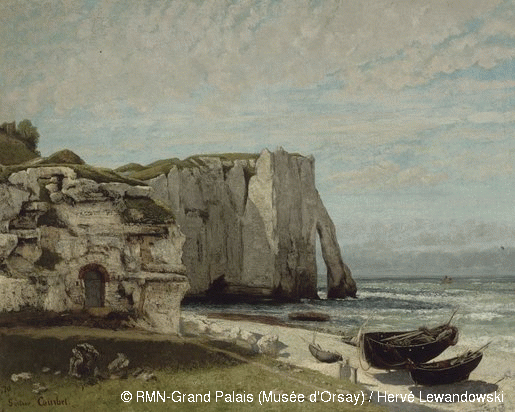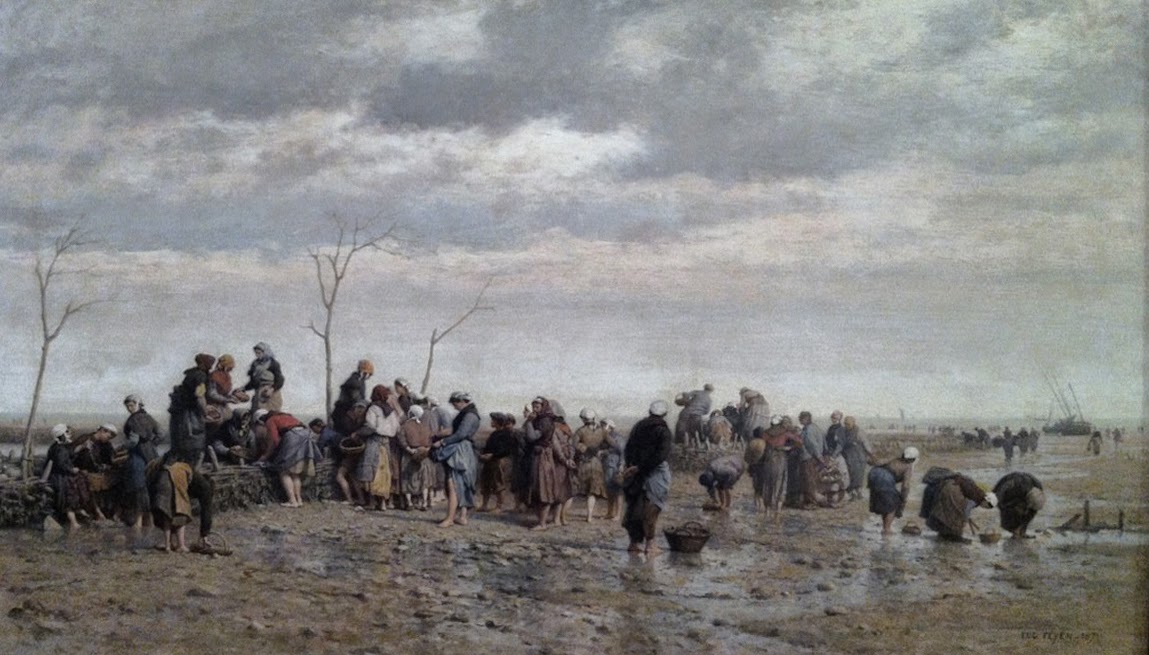After researching this painting and its connection to marine ecology, I am posting this short essay that uses this painting as a springboard for further thinking about the representation of ecological relationships on the Brittany coast.
 Dauchez was a painter, illustrator, printmaker and passionate sailor who, from 1890
onward, spent
summers in Brittany at his family's summer home in Bénodet.
Dauchez was a painter, illustrator, printmaker and passionate sailor who, from 1890
onward, spent
summers in Brittany at his family's summer home in Bénodet.  | |
| Dauchez, Boat on the Odet |
 |
| Dauchez, Benodet, etching, c. 1900. |
|
Sand Boats has the dark, sepia tonality of his prints.
 |
| André Dauchez, Sand Boats, c. 1900-1902. Musée des Jacobins, Morlaix. |
I was initially drawn to his image of the wrack line as it traces the last high tide; calligraphic coffee-brown seaweed is flattened to the tan sand, writing the rim of the intertidal strand. The sea is cold blue-gray, the sky a menacing violet. This is not the sparkling beach of a summer vacation that inspires pastel hues, rather this is a worked zone of the land, exposed by the dropping sea. The Bande Noire artists may have shunned the exaggerated color of Impressionism, but they did not avoid engaging with modernity. Their stylistic and thematic roots were in the gritty realism of Millet and Courbet from the 1850s and 60s. And like the rural Impressionist themes of Camille Pissaro or Claude Monet along the Seine river in the 1870s, Dauchez represented a form of modern, local labor -- on the Brittany coast.
Wooden boats, retired from sardine fishing, have been refitted for the hauling of sand. Beached for the moment, they are being loaded one shovel-full at a time and will float, despite their groaning loads, as the tide comes in. Dauchez, the avid sailor, in his day-trips around the coast, would have seen sand boats working on the beaches of Loctudy, the Isle Tudy and Glénan islands (an archipelago off the south coast of Finistère). This painting was featured in a recent winter exhibition of Post-Impressionism in the museum, and the catalog notes that the site is probably the beach of Trévignon in Tregunc (just east of Concarneau).
But I had to ask, why move sand by water, shoveled by hand? Why this sand?
A bit of hunting for "bateaux de sable" turned up the information that maërl or coral sand was a natural resource, harvested on certain parts of the Brittany coast, and transported on boats known as sabliers. Pierre Primot, a former sablier, tells of the peasant-sailors from Gouesnach (just north of Bénodet, upstream on the Odet river) known in Breton as "gab-mao"; they bought old sardine boats in Douarnenez or Concarneau to haul sand upstream to farmers who either purchased it on the docks in Quimper, or had the sand dumped on a nearby river-bank for their collection. At first the maërl sands were gathered by farmers who took to the waters. This later became a trade in itself, as the demand for this sand expanded from agricultural applications to use in building materials and later water filtration. Dauchez shows us these workers of the strand and river -- farmers of sea /sailors of sand, in their red and blue jackets, as they fill their boats, the sails rolled up into the boom, waiting for the tide and later the wind to take this heavy load upstream.
 |
| http://www.bretagne-racines.ac-rennes.fr/p290695Y/sablier.htm |
On the North Coast of Brittany, the same exploitation of maërl sands moved up the Lannion and Morlaix rivers from surrounding estuaries.
As a modern agricultural practice introduced mid-century, maërl sand was added to reduce soil acidity (similar to the use of lime) and to impart magnesium, iron and other trace minerals. This is a scarce resource today that has led to dragging the ocean floor for maerl, to augment the fertility of the land (other uses of maerl include the making of concrete). In this unsustainable practice, nutrients move across the coastline, somewhat like the action of a swollen river spilling onto its floodplain, but a bit more like the displacement of matter effected by quarrying.
Maërl is a Breton name given to coralline red algae (or calcified algae), which grows in Northern European, shallow (and cool) sublittoral waters at the slow rate of about 1mm per year. Unlike kelp and other rockweeds, maërl does not need to attach to a hard surface, and so can grow across mud, sand or loose pebbly bottoms. In addition to the Brittany coast, this red and rock-hard seaweed grows in the coastal, wave-exposed waters of Ireland, Scotland and Cornwall. The red color of the growing plant bleaches to white when its dead and chalky skeletal remains wash up as sediment, mixed with the silica as sand.
Coralline algae store large amounts of carbon in their cell walls in the form of calcium carbonate. This is the same material that formed the chalk cliffs of Normandy in the Cretaceous period, as calcium carbonate-rich sediment from coccolithophores, skeletal remains of the planktonic algae, gradually accumulated on the bottom of the shallow warm seas that covered much of Northern Europe.
In maërl beds, living algae grow atop layers of dead maerl, forming an environment (like a coral reef) that is inhabited by many other forms of sea life.
An essay on the Nature and importance of Maerl Beds" posted on the UK Special Marine Areas Conservation website notes that living maerl beds are "a unique assemblage of biotopes."
 A "biotope" is "[t]he habitat (i.e. the environment’s physical and chemical characteristics)
together with its recurring associated community of species, operating together at a
particular scale... The habitat encompasses the substratum and
the particular conditions of wave exposure and other factors which contribute to the
overall nature of the location. The term community refers to a similar association of
species which regularly recurs in widely separated geographical locations."
A "biotope" is "[t]he habitat (i.e. the environment’s physical and chemical characteristics)
together with its recurring associated community of species, operating together at a
particular scale... The habitat encompasses the substratum and
the particular conditions of wave exposure and other factors which contribute to the
overall nature of the location. The term community refers to a similar association of
species which regularly recurs in widely separated geographical locations."
The biodiversity of shallow water maërl biotopes is explored extensively in the lavish, full-page illustrations of Etude de la Mer (1913), a deluxe marine biology text magnificently illustrated by Breton artist, Mathurin Méheut. The fleshy mauve of corralline algae repeats through many of Méheut's illustrations of sea life, set "sur un fond d'Algues Calcaires." As Méheut shows us repeatedly, living coralline algae is the essential substrate of its complex biotope. This is noted in the
in the Encyclopedia of Tidepools and Rocky Shores:
"Many organisms have evolved to live in or on calcified algae as an alternative hard substratum. For instance, certain species of bryozoans, hydroids, fleshy seaweeds, and calcified crusts grow directly on articulated coralline fronds in tidepools. Amphipods and polychaetes wrap themselves in calcified articulated fronds, and worms burrow into calcified crusts. Abalone, sea stars, limpets, chitons, and reef corals often recruit to coralline algae. Reef corals, in particular, chemically detect, metamorphose, and settle on or near coralline algae, which presumably indicate favorable coral habitat. Similarly, many corallines grow as epiphytes on sea grasses and other algae and on the shells of snails, mussels, and barnacles. Occasionally the thickness of coralline accumulations
far exceeds that of the shell of the organism on which it is growing." (Steneck and Martone, 2007)
far exceeds that of the shell of the organism on which it is growing." (Steneck and Martone, 2007)
Describing Meheut's images of sea life, Gustave Babin waxed florid in 1913:
Dauchez and Meheut do not give us the romantic notion of a Brittany that is one solid mass of rugged granite. Their images of the shore are specific to the place and, in Dauchez's case, to the practices of the human communities that inhabit it. The living color of Meheut's maerl is gone from Dauchez's pale sand, but both artists present us with a realist vision of the shore's biotopes.
Links:
http://patrimoine.region-bretagne.fr/sdx/sribzh/main.xsp?execute=show_document&id=PALISSYIM22004048
http://arbannour.free.fr/histoire/les_chemins_de_sable.htm
http://www.sand-atlas.com/en/page/16/
http://www.bretagne-racines.ac-rennes.fr/p290695Y/sablier.htm
Pêcheurs de sables by jfp
























































